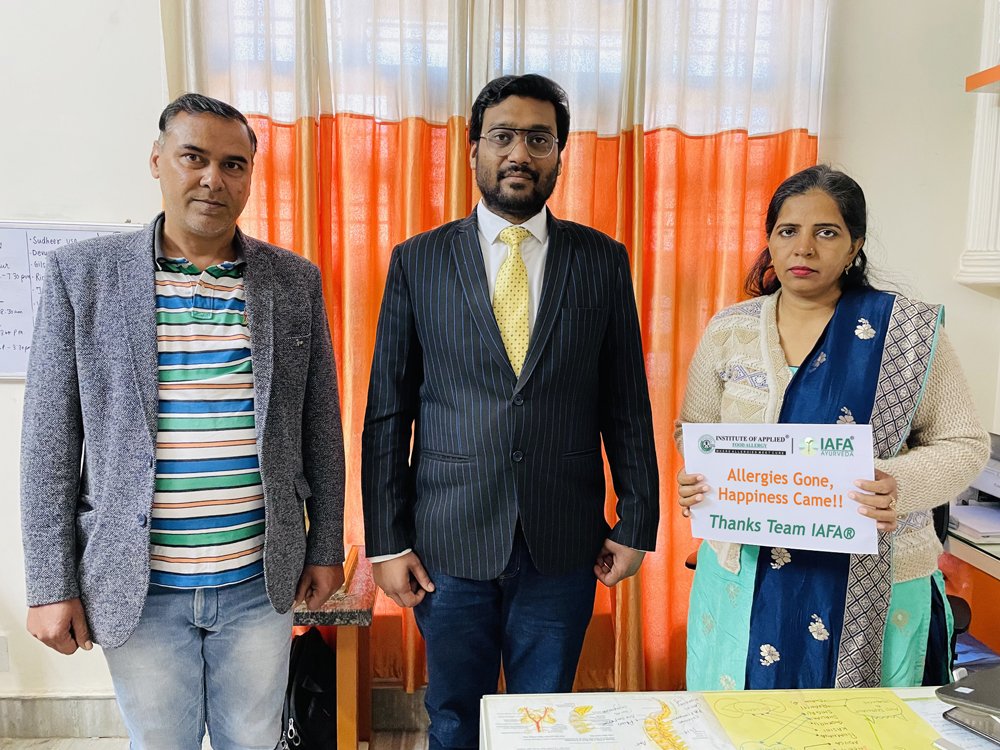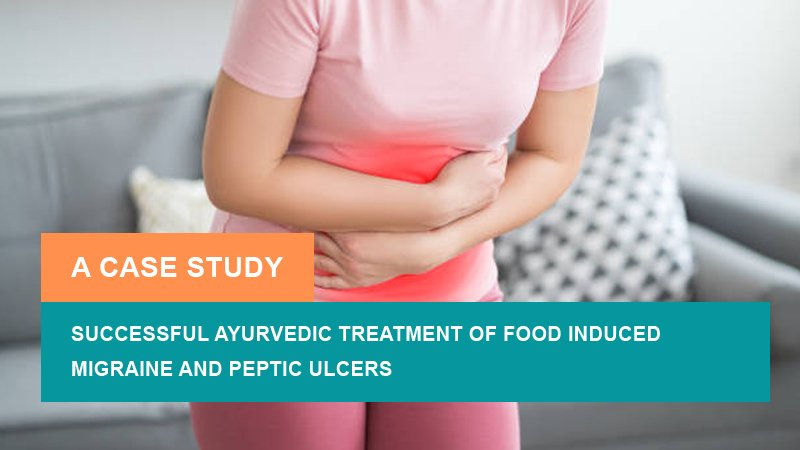Abstract
Sunil Devil hailing from Haryana, India has been suffering from food-induced migraine (Ardhavabhedaka) and Peptic Ulcers. This happens whenever she consumes food that is allergic to her. She further said that she is allergic to gluten, dairy, and avocado.
She visited IAFA® to get Successful Ayurvedic Treatment for Food-Induced Migraine and Peptic Ulcers. After continuous treatment for about 3 months, she felt relieved and there were no recurrent attacks of food-induced migraine and Peptic Ulcers.
Let’s know in detail about the case study of Sunil Devi. When she visited IAFA®, she used to have skin issues like red bumps on the skin after eating allergic foods, gastrointestinal issues like constipation, flatulence, and frequent bowel movements after eating allergic foods. She was suffering a lot from migraine attacks she used to get whenever she had allergic food. IAFA® helps in the elimination of the root cause of the disease. IAFA®’s therapy includes 3 months of herbal medicines along with a personalized diet and yoga asanas that will help you to recover from the disease completely.
The Successful Ayurvedic Treatment for Food Induced Migraine and Peptic Ulcers involves the indication of herbs that will treat her food intolerance, peptic ulcers and reduce the allergic reactions to the particular food. Later she will be treated for her food-induced migraines. Are you enthused to know the case study of Sunil Devi in detail just like we are excited to let you know? Then why wait, let’s get into that straight and have an insightful read!
Case Details
Name: Sunil Devi
Age: 30 years
Gender: Female
UID: 6587
Place: Haryana, India
DOA: 13/10/2021
Introduction
Ayurveda explains food-induced migraines as Ardhavabhedaka. Ayurveda explains Ardhavabhedaka as a condition where people suffer from one-sided headaches whenever they consume food that triggers their immune system. Once the immune system is triggered, it produces hypersensitivity reactions resulting in severe headaches in some and some may get other issues like gastrointestinal issues and skin issues. Our patient is majorly suffering from food-induced migraines but she also has some skin and gastrointestinal issues.
Common Symptoms of Ardhavabhedaka
- Severe pain on one side of the head.
- Eye irritation and disturbances in the ears in severe condition.
- Cracking and throbbing pain.
- Dizziness.
- Nausea and vomiting
- Sensitivity to Light and sound
- Scalp tenderness
Ayurvedic Treatment of IAFA® includes the treatment of all the above-mentioned symptoms.
Common Causes of Ardhavabhedaka
- Hormonal imbalance
- Intake of certain drinks like alcohol, coffee and the food that triggers your immune system.
- Intake of specific foodstuffs like gluten, milk and dairy, cheese, salty food, canned and baked food
- Missing meals
- Lowered intake of water
- Taking food that contains artificial sweeteners and preservatives.
Final Diagnosis
- Ardhavabhedaka (Food induced migraines)
- Amla Pitta (Peptic Ulcers)
Amla Pitta (Peptic ulcers) can be defined as sores that develop in the intestinal lining of the gastrointestinal tract. She has also had symptoms of Amla Pitta, keeping in mind this, Dr. Gupta made her treatment approach.
Dr. Sahil Gupta recommended the patient undergo a 3-month herbal therapy and suggested a personalized diet.
Treatment of Food-Induced Migraine and Peptic Ulcers
External Medication
- AF-7 Bar: Apply the bar all over the body during the bath. It reduces the red bumps that are present in the body and helps to get relief from itching.
Internal Medication
- Dadimavaleha: 2 teaspoons twice a day after meal. It is hematinic, where patients can get sufficient haemoglobin. Sometimes not having a sufficient amount of blood can also cause migraine headaches.
- Pitpapra Capsules: 2 caps. Twice a day early morning and early evening empty stomachs before meals with water. It helps to enhance the Agni in the digestive system thereby enhancing the digestive capacity of the body.
- Aam Visha Balance Tablet: 1 tablet twice a day 1 hour after a meal with lukewarm water. It helps to eliminate all the toxins from the body and provides relief from the allergic reactions that are caused due to the toxins.
- Triphala Capsules: 2 caps at bedtime with water. These capsules help in enhancing the digestive capacity and also reduce skin allergic reactions and nasal congestion.
- Aahar Amrutham Ras: 30 ml twice a day after meal with an equal quantity of water. It helps in boosting the immune system of the body.
- Moringa Capsule: 2 Capsules, one capsule at a time twice a day anytime. It is also an immunity booster.
Successful Ayurvedic Treatment for Food-Induced Migraine and Peptic Ulcers includes the above-mentioned internal and external medications.
Dos'(Pathya)
- Non-dairy creamers (read labels to make sure that your readers don’t have dairy products that cause allergies.)
- Always consume light and easily digestible food.
- Frequent intake of small amounts of lukewarm water
- Include more fiber-containing fruits and vegetables in your regular diet.
- Do not overeat. Always leave a gap of 4 hours between your every meal
- Take old rice, buckwheat, ragi, whole corn, millets and oats.
- Take herbs such as fennel, cumin and curry leaves regularly. This will improve your Agni as well as enhance the absorption of sufficient nutrients. It also stimulates digestive enzyme secretions which will further improve digestion, and absorption and clears away the accumulated toxins from the body.
- Try to consume fruits and fresh juice of pomegranate, Bael and apple daily.
- Old basmati rice (>3 months), barley, moong dal, urad dal, saffron, coriander, yellow and green lentils.
If you want to experience good outcomes and manage Successful Ayurvedic Treatment for Food Induced Migraine and Peptic Ulcers, then you must strictly avoid the below-mentioned foods and also should follow the specialized and personalized yoga asanas.
Don’ts (Apathya)
- High lactose diet: sugar found in dairy, cream cheese, and soft cheeses.
- High-fat foods: butter, coconut, margarine, and cream, as well as fatty, fried, or greasy food, spicy and sour food.
- Packaged food that contains food additives, dye, and artificial sweeteners.
- Yeast-fermented food and fermented beverage items.
- Meat and poultry, Seafood
- Alcohol-based cough syrups.
- Vegetables: Eggplant, ladyfinger.
- Nuts: Pistachio nut, cashew nut, and peanut
- Lentils: Kidney beans, pinto beans, and soybeans
- All leftovers
- Viruddha Bhojana is food that is incompatible with your body.
Herbal Remedies
- Cumin Water: Add 1-2gm teaspoon of cumin to 60ml of water. On a low flame, let the water boil gradually so that the properties of the herb retain and will not evaporate. Strain them out and serve after a few minutes.
- Fennel Water: Add 1-2gm teaspoon of fennel in 60ml of water. Use a low flame and let the water boil gradually so that the properties of the herb persist and will not evaporate. Strain them out and serve after a few minutes.
Along with the internal and external medication, Dr. Gupat has also advised the patient with a personalized diet and herbal remedies. Ayurvedic Treatment of IAFA® also involves some yoga asanas that will help to get relief from migraine headaches.
Yoga Asanas
- Shashankasana
- Hastapadasana
- Setu Bandhasana
- Shishuasana
- Marjariasana
- Adho Mukha svanasana
- Prasarita padottanasana
- Paschimottanasana
The above-mentioned yoga asanas will help you to feel free and stress-relieved from frequent migraine headaches.
Follow-Up: 1st Month
After being used to herbal medicines for about a month and also strictly following the personalized diet, the patient has seen the following outcomes.
- Red bumps on the skin had reduced to around 70%.
- No major gastrointestinal issues like improper digestion and vomiting.
- The frequency of headaches has significantly reduced.
However, the medications should be used for about two more months to get 100% relief from the throbbing pain and headaches.
Follow Up: 2nd Month
Dr. Sahil Gupta has advised the patient to continue the same medications, in addition to that, he further advised not to have or need to completely avoid some foods that are exaggerating the condition.
- No skin rashes or bumps
- No feeling of nausea and vomiting
- But, still, there are some episodes of headaches.
To completely get rid of the headaches, Dr. Gupta has advised following some yoga asanas too that will help to balance the hormonal imbalance and help to recover from the condition.
Follow Up: 3rd Month
After thoroughly using the indicated herbal medicines, along with a personalized diet and yoga asanas, the patient feels 100% relief from the condition and she visited IAFA® and expressed her immense gratitude to Dr. Gupta.
A Happy Note from the Patient:
The patient has personally visited IAFA® and said that her food allergies and intolerances have gone now, and she doesn’t have any digestion issues. She further added that she feels heartfelt gratitude towards the team IAFA® for their immense support and also for Dr. Sahil Gupta for his excellent ayurvedic approach to Successful Ayurvedic Treatment for Food Induced Migraine and Peptic Ulcers.

She now need not suffer from any kind of throbbing and excruciating pain that she used to suffer from before.
Conclusion
Ardhavabhedaka is a half-sided headache where the patient experiences shuddering and dull pain. It may be due to various reasons, but here is our patient who suffers from this due to food allergies. Her migraines arise whenever she consumes food that she is allergic to. But, other alternative treatment approaches can help in getting relief from the symptoms and will not help to recover completely. But, Ayurveda is different, it focuses on the root cause of the elimination of the disease. That’s why Ayurveda takes time and you can get permanent relief.
Dr. Sahil Gupta, an Ayurvedic allergy specialist has been dealing with patients with various kinds of allergies and other disorders for the past 14 years all around the world. No matter where you are, IAFA® is with you in your health journey. Your health is our priority, book an online consultation now and chat with our Ayurvedic specialist, to get your successful management of diseases.







